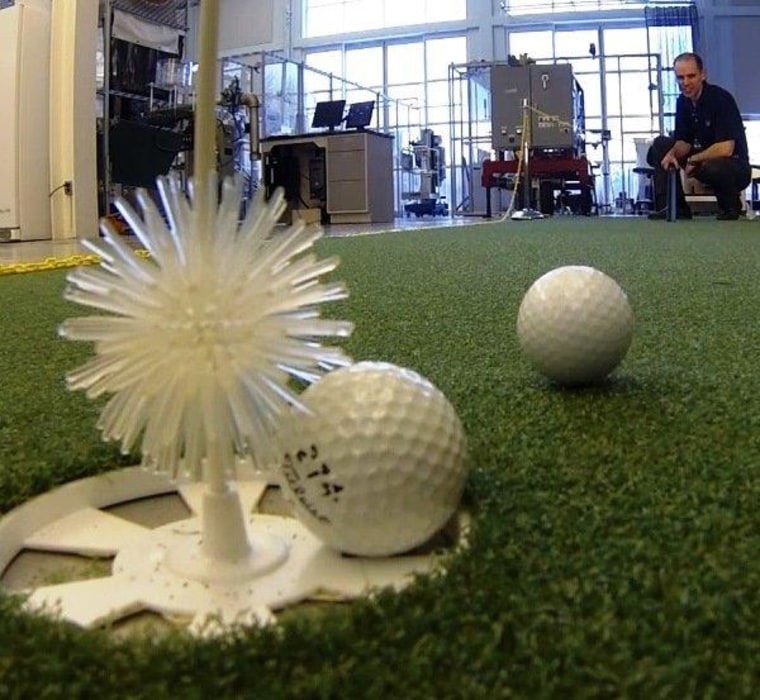Golf might not look like a sport for science geeks, but there's actually a lot of physics and engineering that goes into playing the game right — and making sure it doesn't get played wrong.
"Anything that could be detrimental to the game of golf is important for us to rule on," Steve Quintavalla, senior research engineer at the U.S. Golf Association, told NBC News.
The USGA Research and Test Center, where Quintavalla works, focuses on "finding the best technology and tools for measuring the performance of golf equipment, and doing the best research in the interest of the game of golf," he said. That task involves promoting innovations that improve the game — but it also involves cracking down on some technological twists.
Science of Golf: Evolution of the golf ball
For example, when it comes to golf clubs, if your driver has a head that's too springy, it could be on the "non-conforming list" and thus disallowed for USGA-sanctioned games. The same goes for golf balls: The USGA tests 20,000 balls a year to make sure they conform to the standards for bounciness.
The balance between what's innovative and what's cheating comes through loud and clear in "Science of Golf," a 10-part video series presented by NBC Learn, the USGA and Chevron. It's the latest in a string of science-themed educational packages that also provide lesson plans for science teachers. In each video, a USGA scientist delves into principles such as displacement, buoyancy, kinematics, acceleration and velocity. Golfers explain how they put those principles into practice. And slow-motion video shows you how it all works on the links.

The USGA's standards extend to how the game is played as well as what the game is played with. For example, back in the '60s, a between-the-legs style of putting started coming into vogue. The USGA put the kibosh on that kind of golf-course croquet. "We realized that that would make the putting stroke significantly easier, so we said, 'Hey, that's not golf,'" Quintavalla recalled.
More recently, the USGA stirred up a fuss with a ruling that will ban a practice called anchored putting in 2016. This involves the use of a super-long putter that a golfer can anchor against his or her body and swing like a pendulum. The USGA determined that the practice made it too easy for the golfer to control the club's trajectory.
Science of Golf: Evolution of the golf club
USGA rules apply to tournaments such as the U.S. Open, which begins next week — but it's not yet clear how this latest ruling will apply to the PGA Tour. The PGA of America already has voiced its displeasure with the anchored-putting ban and will consider the matter further at a board meeting this month. Can this be settled scientifically? In sports, as in politics, the answer doesn't always come down to the scientific data. (For more on the debate, check out this analysis of science vs. tradition in golf from the American Science blog.)
Looking beyond the rules of the game, Quintavalla said one of the sport's most promising scientific frontiers has to do with how golfers optimize their performance.
"One advantage has been the use of launch monitors," he said. These are high-tech devices that measure the way the ball comes off the face of the club, using high-speed video cameras or radar. "It's a training aid for coaches to allow them to better instruct players on how to approach the ball differently," Quintavalla explained.
Golf is probably one of the least violent sports out there, and that also extends to the way the USGA enforces its will.
"Players generally police each other," Quintavalla said. "What the USGA does not have is a SWAT team and black helicopters. We don't come to your house in the middle of the night and take your clubs away. The marketplace is governed voluntarily, and that's a good thing. ... What we find is, by and large, golfers don't want to be seen as cheaters."
More 'Science of ...' from NBC Learn
Past "Science of..." packages have touched on chemistry, innovation and our changing planet as well as hockey, football and the Olympic Games.
The science of golf rates a double-birdie, because Chevron is also featuring the subject on its STEM Zone website — where STEM stands for science, technology, engineering and math. Both the videos and the STEM Zone's interactive presentations help you figure out how an intuitive understanding of F=ma helps golfers maximize their performance.
"The new video series showcases the STEM principles that play a key role in a variety of USGA functions, including equipment testing, environmental research and scoring," Sarah Hirshland, the USGA's senior managing director of business affairs, said in a news release.
More about the science of golf:
The U.S. Open will be broadcast on television from June 13 to 16 on NBC and ESPN, and live-streamed via the U.S. Open website. Check in with the Golf Channel for daily coverage.
Alan Boyle is NBCNews.com's science editor. Connect with the Cosmic Log community by "liking" the NBC News Science Facebook page, following @b0yle on Twitter and adding the Cosmic Log page to your Google+ presence. To keep up with NBCNews.com's stories about science and space, sign up for the Tech & Science newsletter, delivered to your email in-box every weekday. You can also check out "The Case for Pluto," my book about the controversial dwarf planet and the search for new worlds.